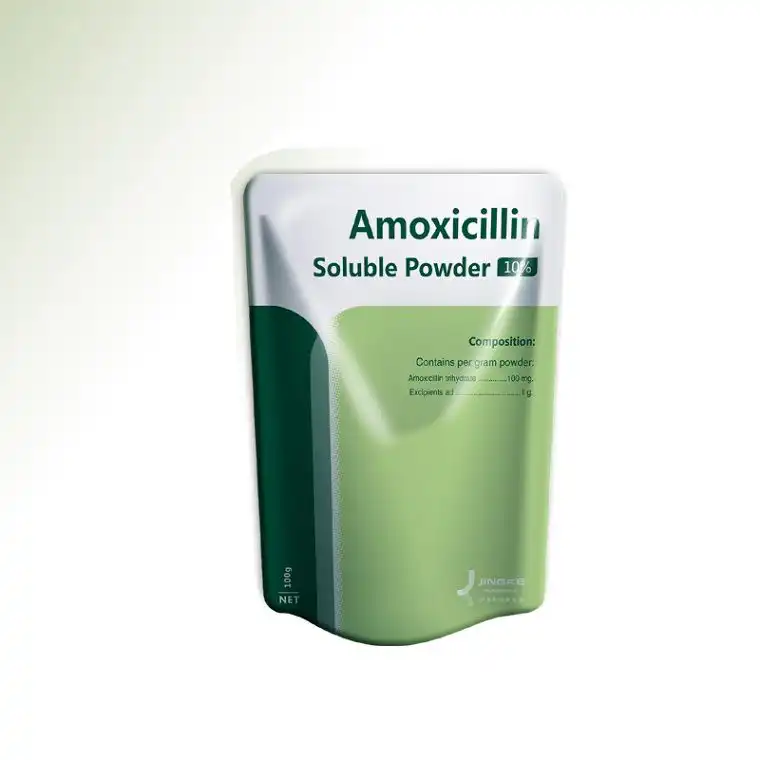As the veterinary drug market becomes more and more standardized, single-ingredient veterinary drugs are now the mainstream in the veterinary drug market. So, among the dazzling many veterinary drug products, amoxicillin and compound amoxicillin (amoxicillin/clavulanate potassium) have become one of the commonly used drugs for veterinary medicine.

However, what is the difference between amoxicillin and compound amoxicillin? There are still many veterinarians and veterinary drug users who are not very clear about them, so that when amoxicillin is very effective, the treatment cost increases due to the use of compound amoxicillin; when compound amoxicillin is needed to be effective, amoxicillin is used by mistake and the treatment is ineffective.
Amoxicillin has a certain drug resistance rate in some areas, while compound amoxicillin is widely sensitive throughout the country. So, when veterinary clinics conduct antibacterial treatment on livestock and poultry, only compound amoxicillin is used, and single-ingredient amoxicillin is no longer considered?
For clinical veterinarians and veterinary drug users, in addition to the basic differences between single and compound prescriptions, drug resistance and sensitivity that can be seen at a glance, you also need to know what diseases amoxicillin is used to treat? Often effective!
First, let’s understand the characteristics of amoxicillin itself and what impact it will have on its efficacy.
- Poor stability. Amoxicillin is very easy to absorb moisture and degrade when exposed to the air, and the effective content will drop sharply. After being exposed to the air for 2 hours, its content will decrease by 10-15%, and after being exposed for 4 hours, its content will decrease by more than 20%; if mixed with feed or diluted with water, its effective content will decrease more rapidly. This is a major factor why the recommended dose cannot achieve the ideal efficacy and must be increased.
- Allergic reactions may occur. Amoxicillin belongs to the penicillin class of drugs. Due to the physical condition of animals, allergic reactions may occur, and even lead to death. In addition, due to the instability of amoxicillin, the byproducts produced during moisture absorption and degradation make allergic reactions more common, which will seriously affect the efficacy of the product, delay the prevention and control of livestock and poultry diseases, and bring huge risks and losses to farms.
Effect of Amoxicillin Powder
The antibacterial characteristics of compound amoxicillin powder on bacterial cell walls are mainly two aspects. First, it has a strong ability to penetrate bacterial cell walls. Compared with other oral penicillin drugs, it can quickly reach the target site; second, it irreversibly acts on PBP2 (penicillin binding protein 2), a key target that determines the integrity of cell wall synthesis, thereby blocking the synthesis of bacterial cell wall mucopeptides, causing bacteria to quickly become spherical bodies and rupture, dissolve, and die. Ampicillin, on the other hand, not only has a relatively weak ability to penetrate bacterial cell walls, but its antibacterial mechanism is to cause bacteria to form filaments and die. The antibacterial characteristics of compound amoxicillin make it almost the strongest oral antibiotic for veterinary use.
The effect of potassium clavulanate in compound amoxicillin not only prevents amoxicillin from being decomposed by resistant enzymes produced by gram-positive bacteria such as staphylococci and streptococci and gram-negative bacteria such as Escherichia coli, Salmonella, and Pasteurella, but also improves the antibacterial activity and sensitivity of amoxicillin; furthermore, the application of potassium clavulanate in the compound can also broaden the antibacterial spectrum of amoxicillin, so that amoxicillin can also achieve effective effects on those gram-positive and gram-negative bacteria that were originally insensitive.
Compound amoxicillin powder is widely distributed in the body, with the highest concentration in the liver, bile and kidney, followed by the lungs, heart, peritoneum, reproductive system and spleen, that is, effective antibacterial concentrations can be reached in the above organs and tissues; the concentration in brain tissue and muscle tissue is relatively low, and the antibacterial concentration can only be reached locally in livestock and poultry meningitis. Therefore, compound amoxicillin powder is suitable for the treatment of bacterial infections in the liver, lungs, heart, peritoneum, reproductive system, kidneys, gallbladder, and spleen of livestock and poultry.
So, what diseases is amoxicillin effective for in clinical practice?
First, it is used as an opening drug for livestock and poultry. For opening drugs for livestock and poultry, it must be a widely used, highly sensitive, broad-spectrum, highly effective drug with the highest safety for animals; compound amoxicillin belongs to such a drug, while amoxicillin does not have such characteristics. Other drugs, such as florfenicol, doxycycline, kanamycin, etc. are not suitable for young livestock and poultry.
Second, it is used to treat digestive tract diseases of livestock and poultry caused by enterococci, enterococci, Clostridium perfringens, etc., and secondary bacterial infections such as salmonella and Escherichia coli. At this time, using amoxicillin alone is mostly very effective; if you are not sure, you can compound an aminoglycoside drug.
Third, it is used to treat various soft tissue diseases of livestock and poultry caused by Gram-negative bacteria infection, such as pericarditis, hepatitis, peritonitis, dermatitis, reproductive system infection, etc. At this time, according to the history of medication, if the local resistance rate to single amoxicillin is high, compound amoxicillin is the first choice.
Fourth, it is used to treat gastric diseases in livestock and poultry. In the past two years, although the incidence of gastric diseases in livestock and poultry in farms has decreased, it still occurs in some areas. Then use “amoxicillin + lincomycin hydrochloride + B vitamins + potassium citrate bismuth”, which is often used for the special treatment of chronic digestive tract diseases such as livestock and poultry gastritis and glandular gastritis.
Fifth, it is used to treat respiratory diseases of livestock and poultry, such as bacterial infections of the lower respiratory tract of livestock and poultry caused by pneumonia, bronchitis and bronchiolitis, mainly Gram-positive bacteria. At this time, the use of single amoxicillin is very effective, and there is no need to use compound amoxicillin.

